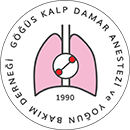

Volume: 19 Issue: 1 - 2013
| REVIEW | |
| 1. | Anesthetic Management of Pulmonary Hypertension Secondary to Pediatric Congenital Cardiac Disease Zeliha Tuncel, Şefika Türkan Kudsioğlu, Zuhal Aykaç doi: 10.5222/GKDAD.2013.002 Pages 2 - 9 (1759 accesses) Pulmonary hypertension associated with congenital heart disease (CHD) is one of the most common causes of morbidity and premature mortality in pediatric patients with CHD. Estimated prevalance of pulmonary hypertension associated with CHD remains 30 % in unoperated paients and 15 % in surgically repaired patients. Pulmonary hypertension is associated with significant perioperative risk for major complications, including pulmonary hypertensive crisis and cardiac arrest. The aim of anesthesiologist should be to minimize increases in pulmoner vascular resistance and depression of myocardial function. |
| RESEARCH ARTICLE | |
| 2. | Comparison of Epidural or Intravenous Patient-Controlled Analgesia at Thoracotomy Gönül Sağıroğlu, Elif Çopuroğlu, Burhan Meydan, Serpil Ertürk, Mine Demir, Mustafa Küpeli doi: 10.5222/GKDAD.2013.010 Pages 10 - 15 (1396 accesses) OBJECTIVE: In this study, we aimed to compare the efficacy and side- effect profiles of morfine in terms of epidural or intravenous patient-controlled analgesia in the pain treatment after thoracotomy. METHODS: Fourty patients were included in our study created as prospective and randomized. Cases were divided into two groups thoracic epidural morphine (TEM) or intravenous morphine (IM), of 20 patient, each. 0.5 mg morfin was given through epidural catheter as preemptive dose before anesthesia induction in TEM group. Patient-controlled analgesia (PCA) was performed for postoperative thoracotomy pain treatment. Visual Analogue Scale (VAS) were questioned at 0.,4.,16. and 24. hours in postoperative intensive care unit. Side effects were also recorded. RESULTS: Between group-comparisons of TEM group at baseline (p<0.025) and 4th hour (p<0.009) found a statistically significant decrease in VAS scores. Intra-group comparisons in both groups, VAS scores showed a significant decrease at all times after 4th hour. There was no significantly differences between the groups on demand of PCA, total amount of analgesic and the amount of additional analgesics. Decrease in heart rate in both groups after 4th hour,compared with baseline values considered to be significant. No difference were found between groups in terms of complications. CONCLUSION: aaaa |
| 3. | Retrospective Analysis of 100 Patients Underwent Lobectomy for Lung Cancer Gönül Sağıroğlu, Burhan Meydan, İlker İskenderoğlu, Elif Çopuroğlu, Mustafa Küpeli, Çağatay Tezel, Aysun Mısırlıoğlu, Erdal Okur doi: 10.5222/GKDAD.2013.016 Pages 16 - 22 (1771 accesses) OBJECTIVE: Lung cancer, mostly non-small cell carcinoma is the leading cause of death (1). We investigated the risk factors that extend the duration of postoperative unit stay or increase the morbidity and mortality, in this study. METHODS: Between January 2009 and October 2009 patients underwent lobectomy for lung cancer were retrospectively analyzed. Sex, age, smoking status, histopathology type, neoadjuvant treatment, co-morbid disease, FEV1, ASA(American Society of Anesthesiologists) score, side and type of lobectomy, length of anesthesia time of mechanical ventilation in ICU, number of transfusions, complications, length of ICU, hospital stay and mortality rates were recorded. RESULTS: In this study, preoperative mean FEV1 value was 79.7%. ASA scores were; 55(55%) ASA I, 22(22%) ASA II, 23(23%) ASA III. The lengthy of anesthesia was 218.81±81 min. The development of BPF was significantly higher at 7% of the neoadjuvant treated patients (p<0.05) and at %14 of the patients transferred to the intensive care unit with a need of intubation tube. Sleeve resections (p<0.0001) and the presence of BPF(p<0.05) were the factors that significantly increase mortality. The mean length of hospital stay was 8.3 days. CONCLUSION: We believe that the incidence of BPF affecting mortality after lobectomy for lung cancer can be reduce with careful anesthesia and attentive surgery. |
| 4. | Simulation Education Of Anaesthesiology And Reanimation Residents: Simmerk® Experience Of The Four Years Kerem Erkalp, Fatma Yeşim Çokay Abut, Dilek Kitapçıoğlu, Gülay Aşık Eren, Mehmet Emin Aksoy, Cengiz Yumru, Ulufer Sivrikaya, Emel Koçer Gür, Naile Toprak, İnci Paksoy, Ayşenur Boztepe doi: 10.5222/GKDAD.2013.023 Pages 23 - 30 (1702 accesses) OBJECTIVE: Simulation-based education, using high fidelity mannequins in a realistic environment, is being increasingly used in undergraduate, postgraduate and continuing medical education. Simulation Education has been also used in a number of medical fields to improve training, clinical performance, competence assessment, and in emercency room or operating room resource management training for anesthesiology residents. METHODS: 375 anesthesiology and reanimation residents (who worked in Istanbul) were educated in Medical Device and Simulation Center (SIMMERK®) between January 2008 and January 2012. Questionnaire results of these anesthesiology and reanimation residents were reviewed. RESULTS: We evaluated the first four years of SIMMERK®, and simulation-based traning in anaesthesiology practise was discussed. CONCLUSION: Simulation-based education is safe and mistake-forgiving environment to teach and learn for anesthesiology residents. |
| EXPERIMENTAL WORK | |
| 5. | The Effectiveness of Bispectral Index Monitoring on Carotid Endarterectomy with General Anesthesia Funda Gümüş, Kerem Erkalp, Sıtkı N. Şinikoğlu, Mehmet S. Sevdi, Abdülkadir Yektaş, Adil Polat, Nihan Kayalar, Ayşin Alagöl doi: 10.5222/GKDAD.2013.031 Pages 31 - 36 (1370 accesses) OBJECTIVE: Carotid endarterectomy (CE) is an established treatment in the prevention of cerebrovascular events. A stroke is the most significant perioperative risk for patients undergoing CE secondary to an embolism or carotid cross-clamping. Several cerebral monitoring techniques are available for detection of cerebral hypoperfusion and ischemia during the carotid cross-clamping. The Bispectral index (BIS) is derived from the electroencephalography and may be useful for the diagnosis of perioperative cerebral ischemia This study was aimed to investigate the BIS changes and associated neurological deficitis during carotid cross-clamping in patients under general anesthesia. METHODS: This study was planned prospectively for patients undergoing elective carotid surgery. Preoperative characteristics were recorded for all patients. The same general anaesthetic protocol and anaesthetic monitorization were performed for all patients. The BIS was used in all patients. BIS measurements were made and recorded at baseline, after induction, at the beginning of surgery, before cross-clamping, at the 1st,2nd,3rd,5th,7th,10th,15th,17th and 20th minutes of clamping and after declamping. The relation of BIS measurements and occurrence of neurologic events were analyzed. RESULTS: The BIS levels decreased significantly only at the 2nd and 3rd minutes after the clamping (p<0.05). However, BIS measurements increased rapidly afterwards. The BIS measurements did not increase significantly at 1st, 5th, 7th, 10th, 15th, 17th and 20th minutes after clamping. We did not observe any neurological deficit in none of the patients. CONCLUSION: Several cerebral monitoring modalities are available for carotid surgery. However, none of the monitorization methods of cerebral ischaemia are perfect. Anaesthesiologists should be careful in order to provide sufficient mean arterial pressure for the brain and the heart. |
| CASE REPORT | |
| 6. | Heparin Resistance and Management During Cardiopulmonary Bypass Operation in a Patient Who Had Previously Received Heparin Therapy Hasibe Özlem Uğur, Mustafa Esat Çilcan, Ayfer Açıkgöz, Pınar Turgut, Bora Aykaç doi: 10.5222/GKDAD.2013.037 Pages 37 - 41 (2036 accesses) In this paper, a case of heparin resistance and its management during cardiopulmonary bypass is reported. A patient with a history of femoral artery embolectomy was treated with intravenous heparin infusion prior to coronary artery bypass surgery. He required 800 IU/kg of heparin and 2 units of fresh frozen plasma to increase his activated clotting time (ACT) to a therapeutic level that is over 400 seconds for safe institution of aortic cannulation. He was diagnosed as a probable heparin resistant case because of the prior heparin treatment. The development of heparin resistance was thought to be due to the consumption of circulating antithrombin III as a result of prior heparinisation. Treatment with fresh frozen plasma restored heparin effectiveness. This case has showed the pivotal role of ACT on the assessment of the efficiency of anticoagulation and the determination of possible case of heparin resistance. |
| 7. | Two Different Anesthesia Management of a Patient with Congenital Hypothyroidism and Bilateral Nephrolithiasis Pınar Ergenoğlu, Oya Yalçın Çok, Şule Akın, Anış Arıboğan doi: 10.5222/GKDAD.2013.042 Pages 42 - 44 (1257 accesses) Congenital hypothyroidism is the congenital deficiency of thyroid hormones characterized by mental and motor retardation. Large tongue, short and thick neck are some morphologic features of the patiets. It is known that patients with hypothyroidism have increased sensibility to respiratory and central nervous system depressants. In this case report, we discussed two different protocols of general anesthesia and postoperative critical care unit follow-up of a patient with congenital hypothyroidism during two percutaneous nephrolithotomy sessions. KEYWORDS: Congenital hypothyroidism, nephrolithiasis, general anesthesia |
| 8. | Bronchial Rupture Due to Endobronchial Intubation with Double-Lumen Tube Burhan Dost, Sami Karapolat, İlknur Suidiye Şeker, Ali Kılıçgün, Ömür Öztürk, Onur Özlü doi: 10.5222/GKDAD.2013.045 Pages 45 - 48 (1917 accesses) Introduction: Postentubation tracheobronchial rupture is a rare serious complication. Case report: In a case of 50 years-old woman, right diaphragmatic elevation causing dyspnea and chest pain complaints was found and right thoracotomy was applied for diaphragm plication. In the case entubated with left side endobronchial intubation tube, mediastinal emphysema occurred during the operation and rupture was found in membranous part of the left main bronchi. Bronchial rupture was repaired primary and the patient was discharged without any complications on the 8th day of postoperative. Conclusion: Taking out style as soon as the tip of the tube passes vocal cords will lower the risk of rupture in the intubations with double lumen endobronchial tubes. In such cases positive results are found with perioperative diagnosis and early primary repair. |
| LETTER TO THE EDITOR | |
| 9. | A Patient With Tracheostomy One-Lung Ventilation With Double-Lumen Tube Hüseyin Toman, Hasan Şahin, Hasan Ali Kiraz, Dilek Ömür, Mesut Erbaş doi: 10.5222/GKDAD.2013.049 Pages 49 - 50 (1297 accesses) Abstract | |
| 10. | Subclavian Vein Catheterization During Ear Pain Selda Muslu, Dilek Kalaycı, Yağmur O. Tanrıverdi, Süheyla Ünver doi: 10.5222/GKDAD.2013.051 Pages 51 - 52 (1245 accesses) Abstract | |

















